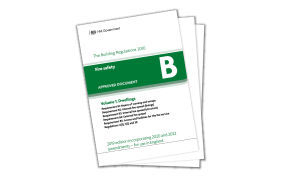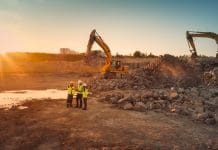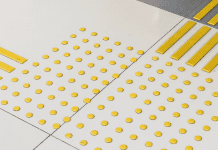Association for Specialist Fire Protection (ASFP) technical and regulatory affairs officer Niall Rowan discusses the implications of the government’s proposed changes to Approved Document B on the passive fire protection industry
The latest government consultation on Approved Document B (AD-B) was published on 23 December 2022 and closed on 17 March. A significant area of concern for ASFP members and the wider passive fire protection (PFP) community is the proposal to remove testing based on BS 476 from AD-B.
In principle, the ASFP has no objection and would even support the move to remove national classifications for reaction to fire and fire resistance from AD-B. However, the move could have a significant impact on some passive fire protection sectors, such as timber fire doors.
Reaction to fire: European and British standards
For reaction to fire, the European standards test a range of scopes of severity which are similar to the British Standards, from Non-combustible/Euroclass A1 down to small-scale ignitability tests/Euroclass E. The European tests measure different parameters to the existing British ones and/or use different measurement technologies, making direct transposition impossible. However, the broad range of classes and their separation is similar.
The exception to this is Class 0. This was originally created as a simple class incorporating flame spread and heat release for internal wall and ceiling linings and research in the 2000s for these products found a good correlation between A1/A2 and non/limited combustibility, for example.
However, no tests were undertaken on cladding materials and certainly none on aluminium composite materials. This led to Class 0 being attained by materials which, when tested under the European system, would typically yield a much lower, worse-performing class. The rest is history. The confusion and poor transposition of Class 0 – particularly in respect of cladding materials highlighted in phase 2 of the Grenfell Tower Public Inquiry – means that the removal of BS classes for reaction to fire is long overdue.
The ASFP supports the removal of national classifications for fire resistance
The ASFP has no objection in principle and would even support the move to remove national classifications for fire resistance. However, as it is currently proposed, it will lead to a situation where the products and the end-use applications of such products will be very restricted since there is no “expert judgement” permitted within this process. The results of a fire test (BS or EN) are only applicable to the item tested, with no variation allowed.
It soon becomes apparent that the combinations and permutations are overwhelming. If Authorities Having Jurisdiction (AHJs) were to insist on a fire test on every combination and permutation of building products, there are simply not enough fire test laboratories in the world to cope with the demand.
This is where the role of assessments comes in; to cover the many combinations and permutations of products and end-use applications that cannot all be tested. These allow engineering judgement to be used within the strict guidelines in the Passive Fire Protection Forum’s Guide to Undertaking Technical Assessments of the Fire Performance of Construction Products Based on Fire Test Evidence, currently referenced in AD-B. However, such assessments cannot be used in the European system.
Furthermore, EN tests are known to be more severe than the BS tests. This will lead to a significant increase in the cost of passive fire protection, with no technical or life safety justification.
Cost concerns from industry professionals
The current situation with some industries, particularly the fire door and hardware industry, is that while there is a lot of testing of steel doors to EN standards, the bulk of the timber fire door sector still tests to BS476. The timber fire door market comprises predominantly UK-based manufacturers who look to solely supply the UK market.
The vast majority of their existing test evidence will become useless. Existing designs will need to be upgraded, causing a massive reduction in product variations, and an increase in product costing. If supporting data for products in the market is from tests based on BS476, assessment and third-party certification will not be allowed to be used going forward.
If the results of European tests (as opposed to classes) for fire resistance can be supplemented by assessments to EN standards then the situation would be improved, providing there is a sufficient transition period.
While a 12-month transition period may be enough for reaction to fire, it is not nearly enough for fire resistance. Manufacturers will need to replicate a vast amount of expensive fire testing, which takes time (many months) and current lead times for fire resistance furnaces are around a year. The ASFP suggests that a period of four to five years should be considered.
Niall Rowan
Technical and regulatory affairs officer
Association for Specialist Fire Protection (ASFP)
Tel: +44 (0) 247 693 5412
info@asfp.org.uk
www.asfp.org.uk
Twitter
Linkedin
Youtube
Instagram

















